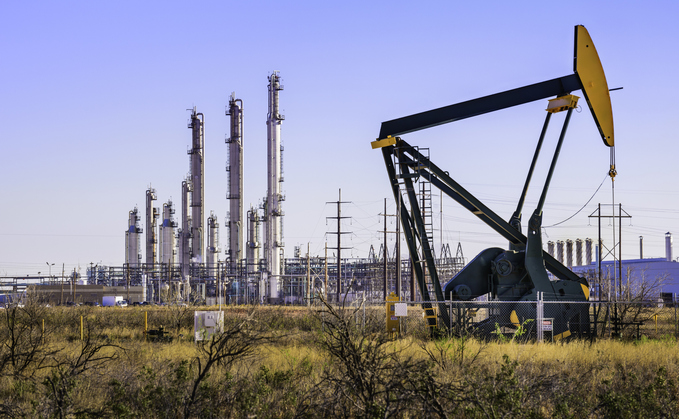An oil refinery in the US | Credit: iStock
Demand for clean technologies and progress on energy efficiency expected to offset growing demand for oil across Asia, International Energy Agency predicts
Growth in demand for oil is set to slow in the coming years, as the roll out of clean technologies and energy efficiency efforts increasingly offsets rising demand for the fossil fuel from Asian markets and the global aviation and petrochemical sectors.
That is according to the latest report from the International Energy Agency (IEA), which predicted carbon emissions from oil could peak as early as 2026 with demand for the fuel likely to peak just a few years later around the end of the decade.
However, the report also shows how that as demand begins to slow, production of oil is still expected to rise in the coming years, pushing up spare capacity "towards levels unseen outside of the Covid crisis".
Published today, the IEA's annual oil market outlook examines the far-reaching implications of the expected shifts in global oil demand and production through to 2030 and beyond for energy security, trade, investment and more worldwide.
Based on current policies and market trends, the report expects strong demand for oil from fast growing economies in Asia, as well as sustained demand from the aviation and petrochemical sectors, to continue in the coming years.
But it expects this growth in demand to be offset by the rapid rollout of renewable energy and clean technologies such as electric vehicles (EVs) and heat pumps, as well as fuel efficiency improvements in road vehicles and declines in the use for oil in power generation.
As a result, the IEA is forecasting that global oil demand - which stood at just over 102 million barrels a day last year - could level off at close to 106 million barrels a day towards the end of the current decade.
Moreover, thanks to shifting patterns of use - with growth largely focused on non-combustion applications such as petrochemicals and a higher share of biofuels - CO2 emissions from oil use could peak as early as 2026, the IEA said.
Meanwhile, increases in production capacity are expected to exceed the sluggish growth in oil demand through to 2030, led by new projects in the US and Central and South America. The report forecasts total oil supply capacity rising to almost 114 million barrels a day by 2030, which it said would amount to a "staggering" eight million barrels a day above projected demand.
That would result in huge amounts of spare production capacity with "significant consequences" for oil prices and markets, including producer countries in OPEC and the US shale gas industry, the IEA warned.
"As the pandemic rebound loses steam, clean energy transitions advance, and the structure of China's economy shifts, growth in global oil demand is slowing down and set to reach its peak by 2030," said IEA executive director, Fatih Birol.
"This year, we expect demand to rise by around one million barrels per day. This report's projections, based on the latest data, show a major supply surplus emerging this decade, suggesting that oil companies may want to make sure their business strategies and plans are prepared for the changes taking place."
The report comes on the same day as a new analysis of the global electric vehicle markets from BloombergNEF, which predicted the surge in demand for zero emission vehicles would mean that the amount oil demand displaced by electric and fuel-cell vehicles of all types is set to more than double, to almost four million barrels a day by 2027. "This is slightly more than the volume Japan consumed in 2022," the report stated.
However, the IEA noted that while growth in demand for oil is expected to slow over the coming years, global oil demand is still forecast to rise over the course of the decade, potentially reaching 3.2 million barrels a day more in 2030 than last year, unless new policy measures or behaviour changes are enacted.
Much of the growth is set to be driven by emerging economies in Asia, where booming transport sectors and petrochemical industries are fuelling demand.
In contrast, advanced economies are expected to oil demand continue its decades-long decline, falling from 46 million barrels a day in 2023 to less than 43 million barrels a day by 2030. That would mean oil demand in these regions hitting its lowest since 1991, barring the Covid-19 pandemic period, the IEA said.
There are signs the oil industry is starting to respond to the reduced demand projections. The report said that as it stands the flow of approved oil production projects worldwide that are set to come online is expected to dwindle by the end of the decade, leading to a slowing and then stalling in capacity growth among leading non-OPEC+ producers such as the US, Brazil, Canada, and others.
The UK could form part of this trend, with the Labour opposition stating it would halt the issuance of new oil and gas drilling licenses in the North Sea if it forms the government following next month's General Election.
But the IEA report stressed that if oil companies proceed with additional projects already on the drawing board - which the agency has previously warned would not align with limiting global warming to 1.5C, as required under the Paris Agreement - a further 1.3 million barrels per day of new capacity could become operational by 2030. If demand slows as expected, such a scenario would lead to further downward pressure on oil prices and growing questions about the level of financial returns offered by higher cost production projects.
"Oil demand growth will slow progressively over the rest of the decade," the report concludes. "The post-pandemic rebound has faded, macroeconomic drivers remain weak and the accelerating deployment of clean energy technologies weighs heavily on key sectors and regions."
You can now sign up to attend the fifth annual Net Zero Festival, which will be hosted by BusinessGreen on October 22-23 at the Business Design Centre in London.










